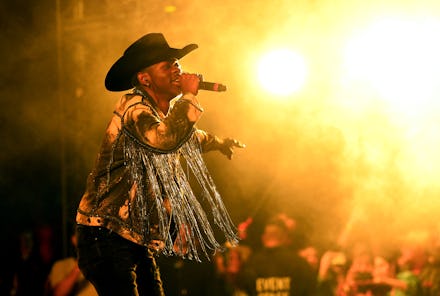The virtual concert boom is creating a new type of live music experience

One of the saddest cultural casualties of the coronavirus pandemic has been live music. Who doesn’t miss packing into a venue with hundreds of other fans to see your favorite artist perform IRL? Notably, virtual concerts sprang up as a stopgap to tide us over until it’s safe to gather again. But with superstars like Billie Eilish and Lil Nas X staging elaborate, mixed-media livestreams in lieu of stadium shows, virtual concerts are morphing into a completely new and thrilling medium that’s reimagining the possibilities of live entertainment.
K-pop superstars BTS were the first act to cement livestreaming as an effective and lucrative way to reach fans during the pandemic. Back in June, the group made a cool $20 million off a single virtual show, "Bang Bang Con," which cost between $26 and $35 to stream and drew an estimated audience of 756,600 viewers.
BTS followed up that success with a subsequent pair of virtual concerts, dubbed “Map of the Soul On:e,” with tickets going for $45 for one performance or $90 for both. According to Big Hit, the group’s record label, some 993,000 fans tuned in from 191 countries. Based on our napkin calculations, the October concerts easily doubled the windfall from June. “Map of the Soul On:e” incorporated slick extended-reality (XR) effects, which leant the show the feel of an immersive music video.
Similarly, Billie Eilish’s “Where Do We Go?” livestream, taped from a soundstage in Los Angeles on October 24, showcased the creative potential of virtual performances. The show was also punched up with XR, which visualized enormous animated creatures and fantastical landscapes swirling around and interacting with the singer.
The spectacle was a massive collaborative effort between immersive production company Moment Factory (which previously worked on her in-person performances), interactive studio Lili Studios (which engineered 3D fan experiences), and livestreaming platform Maestro (which has staged shows for the likes of Tim McGraw in the COVID era). Tickets to Eilish’s show cost $30, but as Rolling Stone sagely pointed out, fans weren’t shelling out for a live music substitute, but rather the privilege of witnessing an entirely new technological feat.
Gaming platforms are also becoming a regular venue for musicians. Travis Scott, for example, drew an audience of 12 million gamers for his Fortnite concert in April, making it the largest gathering in the platform’s history.
This week, Lil Nas X announced that he’ll perform a virtual concert on Roblox, one of the most popular video games for kids, on November 14. It’s a collaboration that’s been in the works for nearly eight months: Roblox approached Columbia Records looking to partner on a major in-game concert, and the label suggested Lil Nas X as a good fit for the platform’s young demographic.
Significantly, one-off livestreams allow artists to reach fans in numbers that simply can’t be matched by traditional stadium shows. Roblox, for example, boasts more than 150 million monthly active users. Stunningly, more than half of American kids under 16 play the game. And that built-in community offers musicians the opportunity to perform for a frankly massive audience. Even Beyoncé recently scrapped plans for a 2021 tour in favor of livestreamed concerts.
“Always, but right now especially, we have to find new and innovative ways to reach and find and to create communities,” Ryan Ruden, Columbia’s senior vice president of experiential marketing and business development, told Rolling Stone. “When you can reach 150 million kids in one go, that’s different.”